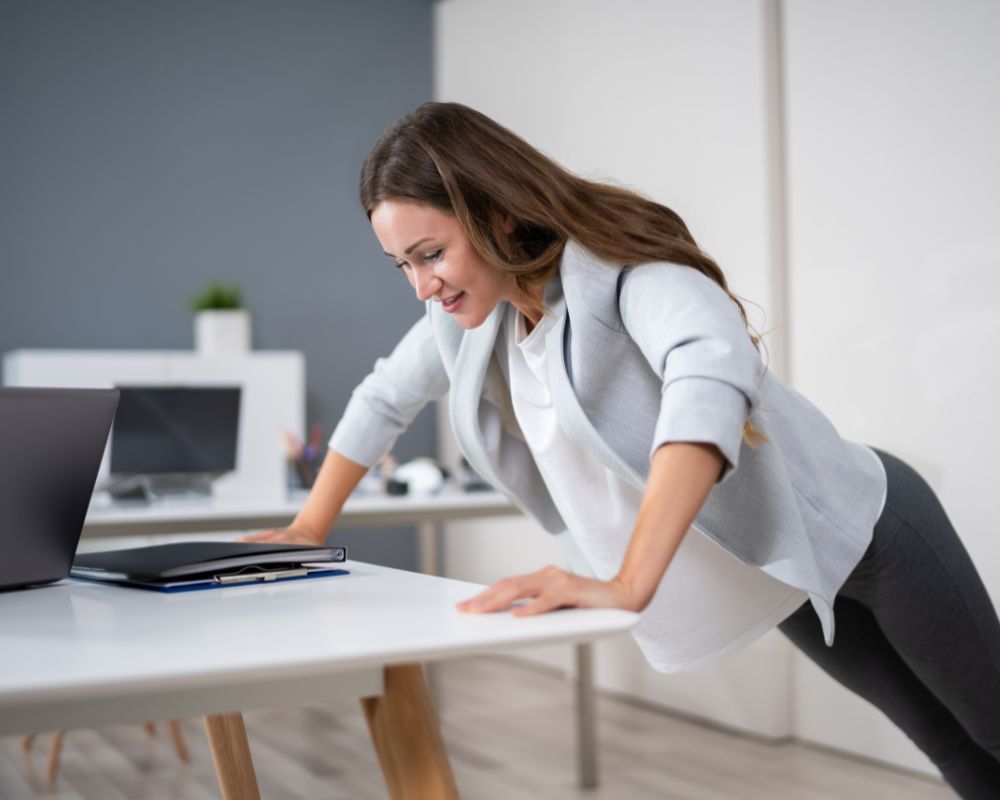Do you find yourself glued to your desk for hours on end? This kind of lifestyle can have a very negative impact on your health. However, staying active at a desk job is not only possible but also necessary for maintaining good health and productivity. Let’s explore the concept of “deskercise,” a series of exercises and activities designed to keep you moving even while you’re at your desk.
The Importance of Movement
Sitting for long periods of time can lead to many health issues, including obesity, heart disease, and musculoskeletal disorders. The human body is designed to move, and when we neglect this basic need, our health suffers. Deskercise offers a practical solution by incorporating movement into your daily work routine, helping to decrease the risks that go along with a sedentary lifestyle.
Adding desk exercises into your day can improve circulation, increase energy levels, and even boost cognitive function. By taking short breaks to stretch and move, you can maintain a healthier balance between sitting and activity, which is crucial for long-term well-being. Be very conscientious about getting up and moving around. I can get so wrapped up in my work I like to set an alarm on my phone when it’s time to get up and walk around.
Get Started with Simple Exercises
Starting a deskercise routine doesn’t require a gym membership or special equipment. Begin with simple stretches that target the neck, shoulders, and back—areas that often become tense from sitting. For example, try shoulder shrugs by lifting your shoulders towards your ears, holding for a few seconds, and releasing. Repeat this several times to relieve tension. You can also rotate your shoulders moving them from front to back.

Another easy exercise is rolling your head gently from side to side or front to back. Just be make sure you do not over extend but keep the movements controlled.
Another easy exercise is the seated leg lift. While sitting, straighten one leg and hold it in place for a few seconds, then lower it back down without letting it touch the floor. Alternate legs and repeat. This exercise engages your core and leg muscles, promoting better posture and circulation.
Integrating Deskercise into Your Daily Routine
To make deskercise a habit, schedule short breaks throughout your day specifically for movement. As I said before, set a timer to remind you to stand up and stretch every hour. You can also use tools like smartphone apps or browser extensions that prompt you to take activity breaks. A smartwatch will also tell you when it’s time to stand.
During these breaks, perform a quick series of deskercises or simply walk around your office. Even a few minutes of movement can make a significant difference in how you feel and perform throughout the day. Try a few
Ergonomics and Deskercise
Ergonomics plays a vital role in facilitating deskercise. An ergonomically designed workspace can reduce strain and create a more comfortable environment for movement. Consider an adjustable chair that supports your spine’s natural curve, or an adjustable desk that allows you to alternate between sitting and standing.
Proper monitor height and keyboard placement can also reduce the need for movements that lead to muscle strain. By setting up your workspace with ergonomics in mind, you’ll be more comfortable and more likely to engage in regular deskercise.
Deskercise for the Upper Body
Upper body deskercises can limit the stiffness and discomfort that comes from typing and using a mouse all day. Try desk push-ups by placing your hands on the edge of your desk and performing push-ups at an angle. This exercise targets your chest, shoulders, and arms.

Another really good upper body deskercise is the seated twist. While sitting, place your right hand on the outside of your left knee and gently twist your torso to the left, holding for a few seconds before switching sides. This movement helps stretch your back and oblique muscles.
Deskercise for the Lower Body
Don’t neglect your lower body when deskercising. Seated calf raises are a discreet way to work your lower legs. Simply lift your heels off the ground while keeping your toes on the floor, then lower them back down. Repeat this motion to strengthen your calf muscles.
For your thighs and glutes, try seated squats. Stand up from your chair, lower your body back down to a squat position just above your chair, and stand back up. This exercise can be done without drawing attention, making it perfect for the office environment.
Deskercise for Core Strength
A strong core is essential for good posture and reducing back pain. Engage your core with seated abdominal squeezes. Sit up straight, take a deep breath, and as you exhale, contract your abdominal muscles. Hold for a few seconds and release. Repeat this throughout the day to strengthen your core.
Another core deskercise is the seated oblique twist. Hold a water bottle or book with both hands in front of you and twist your torso to one side, then the other, keeping your hips facing forward. This exercise targets the oblique muscles and helps with rotational flexibility.
Stay Motivated and Make Deskercise Fun
To keep your deskercise routine from becoming monotonous, mix up the exercises and challenge yourself with new movements. You can also involve your coworkers by starting a deskercise group or sharing tips and progress with each other.

Make deskercise more enjoyable by creating a playlist of upbeat music to energize your sessions, or use a fitness tracker to set goals and monitor your activity levels throughout the day. I love my fitness tracker and I set goals as to how many steps I need to have each hour.
The Long-Term Benefits of Deskercise
Regular deskercise can lead to significant improvements in your health and work performance. By reducing sedentary behavior, you can lower the risk of chronic diseases, improve mental health, and increase productivity. Deskercise also promotes better posture, which can reduce the likelihood of developing musculoskeletal problems.
In the long run, adding movement into your workday can lead to a more balanced lifestyle, where work and wellness go hand in hand.
Summary
Incorporate simple exercises into your daily routine to help you improve your health, boost your energy, and enhance your work performance. Remember to regularly take movement breaks, set up an ergonomic workspace, and stay motivated by making deskercise enjoyable. These simple strategies can help, you stay active and healthy, even at a desk job.

